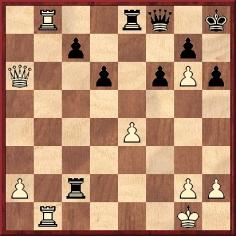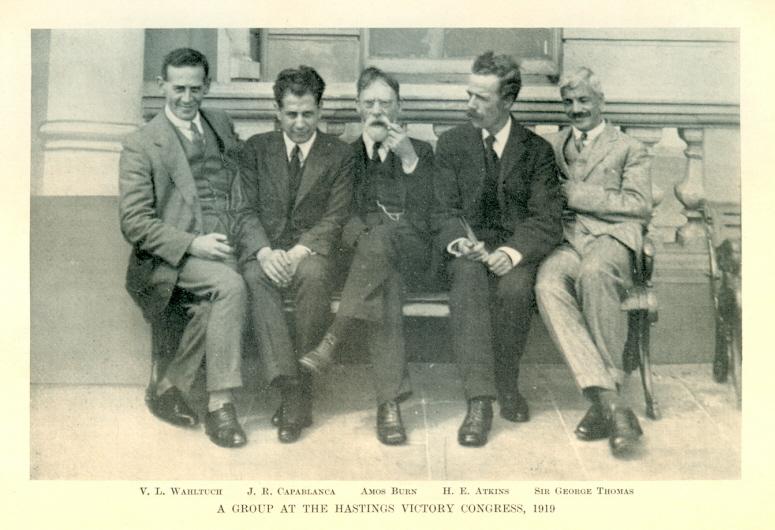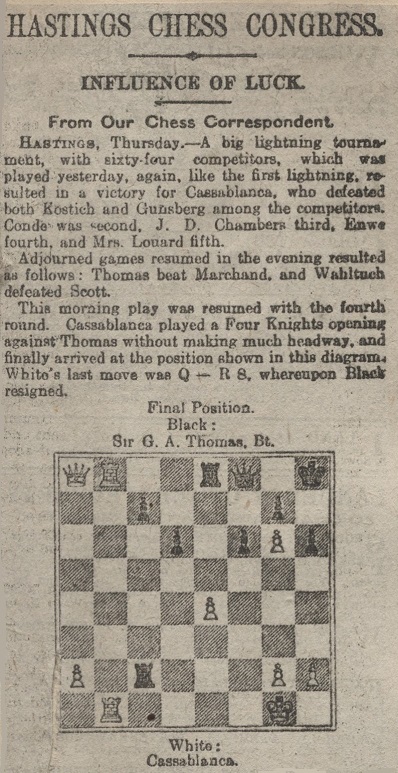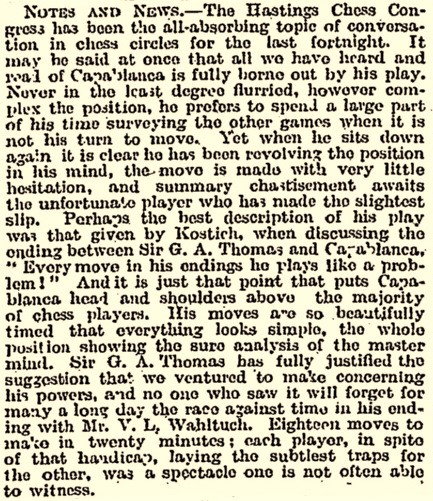
Edward Winter
One of the most celebrated double blunders in chess history occurred in the game between Capablanca and Sir George Thomas in Hastings on 14 August 1919.

The game ended 29 Qa8 Resigns, but Capablanca could have won a rook with 29 Rxe8 Qxe8 30 Qa4. Instead of resigning, Black could have drawn with 29...Rxa2.
The mistakes were immediately noted at the time. In The Field Amos Burn called 29 Qa8, ‘a remarkable oversight’, adding, ‘And it was perhaps still more remarkable that Sir George Thomas, thinking he had a lost game, should have resigned without examining the position’. Burn’s notes were given when the game was discussed on pages 206-207 of the September-October 1919 American Chess Bulletin. The magazine described the game as ‘one of the most curious in the annals of chess play’.

From A Century of British Chess by P.W. Sergeant (London, 1934)
Brian Harley related the Capablanca v Thomas incident on pages 11-12 of his book Chess and its Stars (Leeds, 1936):
‘Capablanca played Q-R8, and Thomas forthwith resigned, seeing no reply to the threat, RxR. Thereupon Capablanca walked out of the room, and a hubbub arose. A spectator had found something. Thomas could have carried on with RxRP, meeting RxR by RxQ, or QxR by RxR. A draw would be the legitimate result of either variation. Further and greater hubbub. Spectator No. 2 pointed out that Capablanca could have won offhand, in the position shown above [our diagram] by RxR, forcing the reply QxR, and then Q-R4. This move attacks both queen and rook, and must win a rook. QxQ allows R-Kt8 mate [sic]; if R-B8ch, simply K-B2, when Black is no better off. I had the temerity to indicate this series of accidents to Capablanca as he walked back into the hall, receiving in return a specimen of the look that I have described at the beginning of the chapter.’ [From page 1: ‘He pinches the tip of his aquiline nose in a musing way – a sign of puzzlement that he carried to his manhood.’]
On page 21 of Cabbage Heads and Chess Kings (London, 1960) Bruce Hayden wrote:
‘Among the most illustrious kibitzers of history is the great Joseph Henry Blackburne.
It was he who was responsible for demolishing Capablanca’s play in his famous ending against Thomas in the Hastings Victory Tournament of 1919. I have this on the authority of E.G. Sergeant, the veteran English player, who was present.’
The Times, 15 August 1919, page 13, stated that the on-site analysts included not only Blackburne but also H.E. Atkins, A. Burn and R.C. Griffith, and that Capablanca’s own reaction was as follows:
‘I am not one of those foolish people who make excuses for everything; it was a complete oversight.’
(5310)

Instead of winning a rook with 29 Rxe8 Qxe8 30 Qa4, Capablanca played 29 Qa8. Thomas then resigned, but could have drawn with 29...Rxa2.
We add now that Fred Reinfeld gave the position on pages 100-102 of Why You Lose at Chess (New York, 1956). After 29 Qa8 he wrote:
‘Convinced – in fact, overwhelmed – Thomas resigned without looking any further.
And yet he had a won game. [Emphasis added by us.]
How? Simply by playing: 29...Rxa2!! If now 30 Rxe8 Rxa8 31 Rxf8+ Rxf8, and Black is in no danger, with a pawn to the good. Or 30 Qxa2 Rxb8, with the same result.’ [Reinfeld’s notes have been converted to the algebraic notation, with the moves renumbered.]
The reference to ‘a won game’ for Black may be regarded as an exaggeration, given that the rook ending appears to be a clear draw if White brings up his king immediately.
Concerning the claim that Blackburne was the onlooker who discovered that Thomas could have saved the game, C.N. 5310 mentioned that Bruce Hayden had named E.G. Sergeant as his authority for that information. On page 20 of the January 1988 BCM, however, Hayden indicated that his source was Brian Harley.
(5837)

Concerning this position from Capablanca v Thomas, Hastings, 1919 [1 e4 e5 2 Nf3 Nc6 3 Bb5 d6 4 Nc3 Nf6 5 d4 Be7 6 O-O Bd7 7 Re1 Nxd4 8 Nxd4 exd4 9 Qxd4 Bxb5 10 Nxb5 a6 11 Nc3 O-O 12 Bg5 Nd7 13 Bxe7 Qxe7 14 Nd5 Qd8 15 Re3 Ne5 16 Rg3 f6 17 f4 Nc6 18 Qc3 Rf7 19 f5 Qf8 20 Qb3 Kh8 21 Nf4 Ne5 22 Qxb7 Rb8 23 Qxa6 Rxb2 24 Rb3 Rxc2 25 Rab1 h6 26 Ng6+ Nxg6 27 fxg6 Re7 28 Rb8 Re8 29 Qa8 Resigns], our earlier items mentioned how Capablanca played 29 Qa8, missing the win of a rook with 29 Rxe8 Qxe8 30 Qa4.
From Gerd Entrup (Herne, Germany):
‘A second winning move is 29 Qb5 (and if 29...c6 30 Rxe8 Qxe8 31 Qb8, with mate to follow). The move was given on page 262 of Kasparov’s first “Predecessors” volume, but I believe that the first person to find it was Klaus-Jürgen Schulz. In his column “Der Leser ist am Zug” on page 17 of the 10/1986 Europa-Rochade he gave the position before White’s 29th move, and on page 28 of the 12/1986 issue he indicated two winning moves: 29 Rxe8 and 29 Qb5.
The diagrammed position was also included in a column by N.H. Yazgac devoted to computer-testing of positions on page 16 of the 11/1986 Europa-Rochade. Only 29 Rxe8 Qxe8 30 Qa4 was given as the winning line, but on page 22 of the 8/1987 issue the second win, 29 Qb5, was pointed out by a reader, Klaus Kiefert of Krefeld. It had been found by his Psion Chess computer program, and a number of variations were provided.’
We add that on page 49 of the February 1982 Chess Life a Texas reader, John Wayland, suggested 29 Qa7. Pal Benko replied:
‘Don’t look for a more clear-cut win than the one given: 29 Rxe8 Qxe8 30 Qa4! Your 29 Qa7 runs into trouble after 29...Rc1+! 30 Rxc1 (or 30 Kf2 Rxb1) 30...Rxb8.’ [The notation and move numbering have been adapted by us.]
(6028)
Page 99 of Der fertige Schach-Praktiker by Franz Gutmayer (Leipzig, 1923) stated that Capablanca’s victory against Sir George Thomas (Hastings, 1919) was played in New York.
(7409)
Michael Clapham (Ipswich, England) has forwarded a cutting from the Daily Telegraph, 15 August 1919:

Our correspondent adds that the newspaper gave Capablanca’s name correctly in its reports on other days.
(9541)
Addition on 24 December 2023:
C.N. 4 quoted a misguided remark by Kostić about the Capablanca’s play against Thomas, from page 452 of the Times Literary Supplement, 21 August 1919:
‘Every move in his endings he plays like a problem.’

The remarks about the lively draw between Sir George Thomas and V.L Wahltuch are also notable.
See too Sir George Thomas.
To the Chess Notes main page.
To the Archives for other feature articles.
Copyright: Edward Winter. All rights reserved.